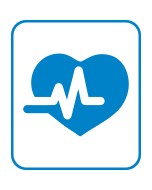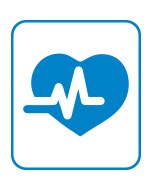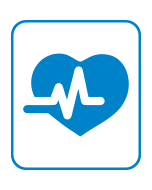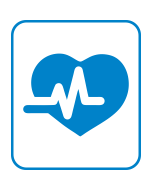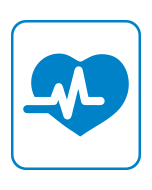Global Hospital-based Medical Device Connectivity Market, Forecast to 2022
Global Hospital-based Medical Device Connectivity Market, Forecast to 2022
Healthcare Digitisation and Personalised Monitoring Yields Novel Growth Opportunities for Networked Medical Devices
27-Apr-2018
North America
Description
For the last few years, healthcare providers globally have been focusing on implementing Electronic Medical Record (EMR) systems and fine-tuning workflow and functionalities to best suit end-user needs. In many countries, the implementation of EMRs has seen high adoption and has been quite successful. It is widely accepted that there can be many potential improvements in the care delivery process and patient safety through the effective use of an EMR. It is not the time for the industry to be complacent. Hospitals are tasked with the need to do more with less, while also keeping pace with technology and patient expectations. In many hospitals, nurses and clinical staff spend half of their working hours per shift on documentation activities, whereas they should ideally be spending most of their focus on direct patient care. What is the advantage of having expensive EMRs when providers have to note patient vitals and key parameters in some cases still on paper and manually key-in those into the electronic record? Improved care coordination also requires accurate, complete, and automated data capture. Medical device connectivity and interoperability is quickly becoming a top priority at hospitals and in healthcare settings because of the numerous benefits it offers across the care continuum. A well-established device connectivity strategy can help hospitals implement clinical alarms based on early warning scores, automated electronic charting, emergency alert and response systems, virtual intensive care units (ICUs), continuous patient surveillance and remote patient monitoring, medical device asset management, and real-time location solutions.
The high-acuity care environment is dynamically changing globally, especially with regard to operating rooms, intensive care units and their workforce. The growing shortfall of intensive care workforce is challenging the ability of hospitals to care for critically ill patients. There is a growing need for intensivists and trained nursing staff to care for critically ill patients in acute care settings. In many countries, a shortfall of intensivists poses a real challenge; there is either a short supply or they are entirely absent, with workloads being shared by non-trained hospital personnel. It is quite evident that expert care from specialists can improve patient outcomes and shorten hospital stays, thereby reducing costs and minimising length of stay and readmissions. As an alternative to critical care delivery models, hospitals can leverage EMRs and medical device connectivity solutions to overcome the shortages of intensivists in the high-acuity care environment.
Medical devices compliant with the healthcare enterprise (IHE) patient care device (PCD) regulation can establish connectivity with the enterprise hospital network for sharing patient-generated data. A centralised patient surveillance platform offering end-to-end medical device connectivity acquiring patient data in real time, intelligent clinical alarm systems with advanced analytics, a clinical-decision support system (CDSS) and a virtual ICU solution can address the challenges in the intensive care environment. Bi-directional communication between connected medical devices and clinical information systems (CIS), particularly for smart infusion pumps programming and multi-parameter patient monitoring has proven to prevent adverse events in the high-acuity care environment. A well-integrated system with a centralised clinical dashboard with real-time insights on patients can help intensivists by prioritising patients that require higher levels of care.
Research Highlights
Frost & Sullivan’s new research report on the Global Hospital-based Medical Device Connectivity Solutions Market, Forecast to 2022 provides a comprehensive analysis on the global medical device interoperability market with a competitive landscape covering clinical information technology (IT) systems vendors, medical device original equipment manufacturers (OEMs), vendor-agnostic third-party medical device data systems (MDDS) vendors, and healthcare system integrators. Please reach out to us to know more about medical device interoperability solutions and numerous methods to establish connectivity of your medical devices with the hospital network regardless of device types.
Presented Segmentation:
- Clinical IT Systems Vendors
- Medical Device OEMs
- Vendor-Agnostic Connectivity Vendors
- Healthcare System Integrators
Key Issues Addressed
- What are the key market trends and industry dynamics in the medical device connectivity market? What is the future potential for medical device connectivity solutions?
- What is the current market scenario? How much growth is expected? Which are the major market segments? What will be the impact of external trends on each business segment?
- Who are the major participants in the global market for medical device connectivity? What are their solution offerings, product features and technical specifications?
- What is driving the market? What are the restraints impacting growth opportunities for medical device connectivity in the global market?
- What are the important business model considerations for healthcare stakeholders and providers? Are there any unmet customer needs? Is there an untapped opportunity in this market?
- Are the connectivity solution offered by solution vendors today meeting end-user needs? Does it require additional enhancements to address critical business needs?
RESEARCH: INFOGRAPHIC
This infographic presents a brief overview of the research, and highlights the key topics discussed in it.Click image to view it in full size
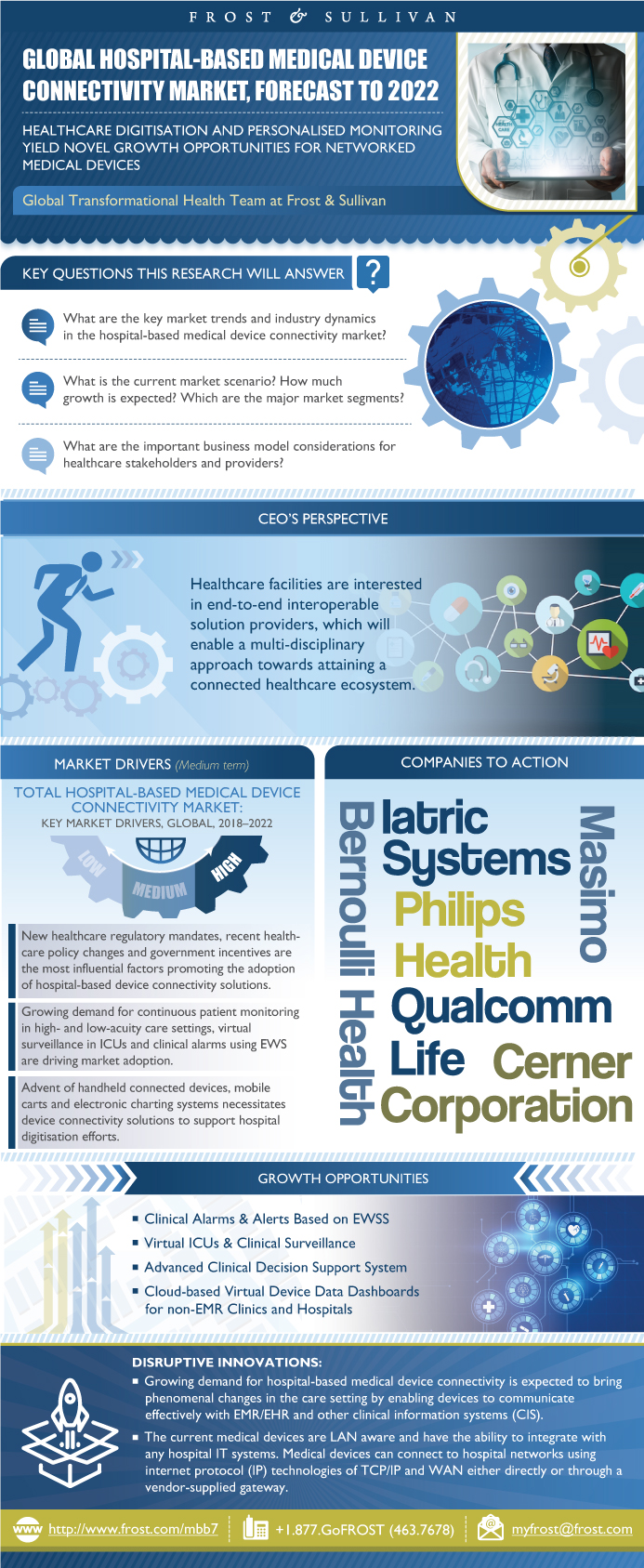
Table of Contents
Key Findings—Study Highlights
Medical Device Connectivity—Trends Analysis
Connected Devices—Real-World Integration Benefits
Key Findings—Geographic Outlook
Study Scope and Segmentation
Key Questions this Study will Answer
Market Engineering Measurements
Key Findings—Hospital-based Medical Device Connectivity
Key Findings
Key Findings (continued)
Key Findings (continued)
Key Findings (continued)
Key Companies to Watch
CEO’s Perspective
Five Growth Opportunities Critical for Future Success
Futuristic Roadmap—Medical Device Connectivity
Top Predictions—Hospital-based Medical Device Connectivity
Medical Device Connectivity—Introduction
Introduction to IHE-Patient Care Devices (PCD)
IHE Patient Care Devices Profiles
Categories of Medical Devices and its Purposes
Device Connectivity Across the Clinical Landscape
Benefits of Medical Device Data Interoperability
Connected Healthcare Ecosystem
Wireless Connectivity Technologies in Medical Devices
Benefits of Enterprise Device Connectivity Strategy
Market Background
Market Segmentation
Key Market Segmentation by Solutions
Methods of Establishing Medical Device Connectivity
Clinical Workflow Overview—Electronic Documentation
Medical Devices Outbound Communication
Medical Device Connectivity—Workflow Model
Clinical Workflow Overview—Connected Devices Landscape
Growing Demand for High-Acuity Device Connectivity
Analysis on Key Medical Devices Desired for Connectivity
Summary of Key Medical Devices Desired for Connectivity
Market Impact of Top 8 Trends—Promising Market Opportunities in Hospital Device Connectivity
Key Market Trends—Hospital Device Connectivity (Top 8)
Key Market Trends—Explained
Industry Dynamics Impacting Device Connectivity Market
EU-General Data Protection Regulation (EU-GDPR)
EU-General Data Protection Regulation (EU-GDPR) (continued)
European Union-Medical Device Regulation (EU-MDR)
European Union-Medical Device Regulation (EU-MDR) (continued)
Heat Map—Hospital-based Medical Device Connectivity
Heat Map—Research Parameters Discussion
Implementation and Cost Factors Assessments
Market Drivers
Market Restraints
Evolving Products and Services Centred Around Hospital Device Connectivity Solution
Evolving Products and Services Centred Around Hospital Device Connectivity Solution—Description
Evolving Products and Services
Evolving Products and Services (continued)
Detailed Medical Device Connectivity Solution Segmentation
Detailed Vendors Segmentation
Competitive Market Structure
Key Company Profiling and Product Overview
Key Company Profiling and Product Overview (continued)
Key Company Profiling and Product Overview (continued)
Merger, Acquisition and Partnership Assessment
Merger, Acquisition and Partnership Assessment (continued)
Merger, Acquisition and Partnership Assessment (continued)
Organisations Influencing Medical Device Connectivity
Organisations Advancing Medical Device Connectivity
Global Trends, Regulatory Mandates and Key Initiatives
Market Engineering Measurements
Forecast Assumptions and Definitions
Revenue Forecast
Revenue Forecast Discussion
North America Breakdown
Revenue Forecast—North America
Revenue Forecast by Region—North America
Revenue Forecast Discussion
Penetration Analysis—The United States
Western Europe Breakdown
Revenue Forecast—Western Europe
Revenue Forecast by Region—Western Europe
Revenue Forecast Discussion
Revenue Forecast Discussion (continued)
Penetration Analysis—Hospital Device Connectivity: Europe
Asia-Pacific Breakdown
Revenue Forecast—APAC
Revenue Forecast by Region—APAC
Revenue Forecast Discussion
Penetration Analysis—Hospital Device Connectivity: APAC
Strategic Business Imperatives for Hospital-based Medical Device Connectivity Solutions Vendors
Legal Disclaimer
Market Engineering Methodology
List of Acronyms Used
List of Exhibits
List of Exhibits (continued)
List of Exhibits (continued)
Popular Topics
| No Index | No |
|---|---|
| Podcast | No |
| Author | Dinesh Kumar |
| Industries | Healthcare |
| WIP Number | MBB7-01-00-00-00 |
| Keyword 1 | Medical Device Connectivity |
| Is Prebook | No |
| GPS Codes | 9564-B1,9575-B1,9600-B1,9612-B1,9825-B1,99BB-B1,99BC-B1,99BD-B1,9A06-B1,9A55-B1 |
 USD
USD GBP
GBP CNY
CNY EUR
EUR INR
INR JPY
JPY MYR
MYR ZAR
ZAR KRW
KRW THB
THB